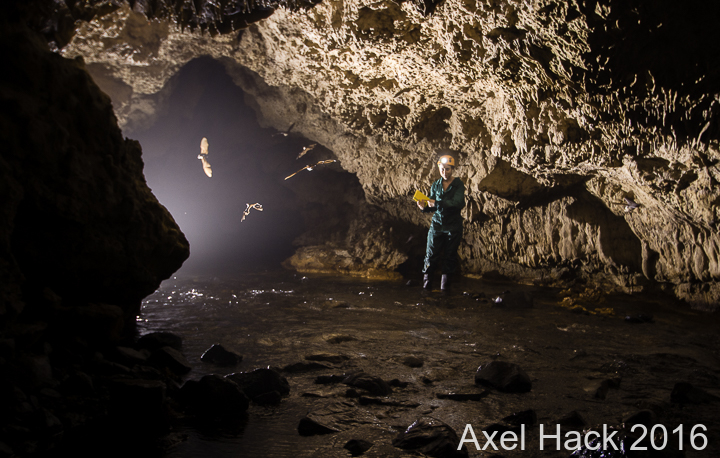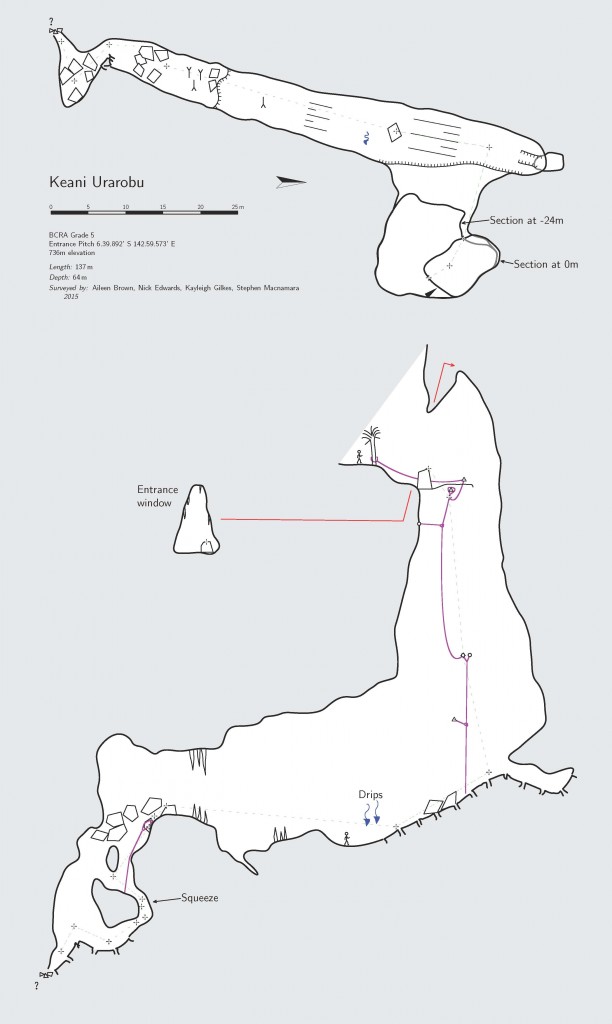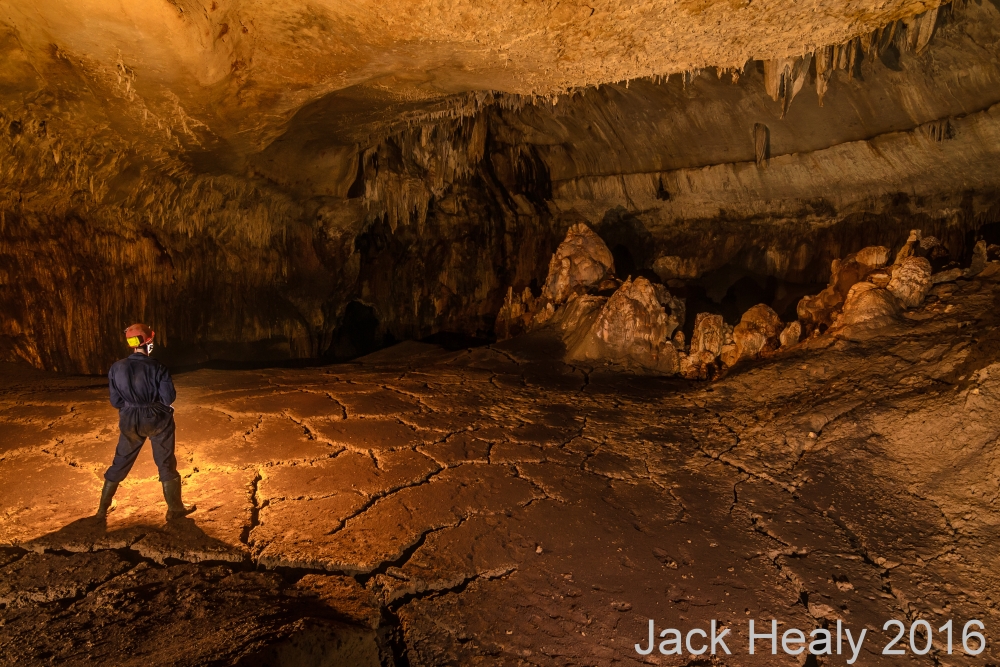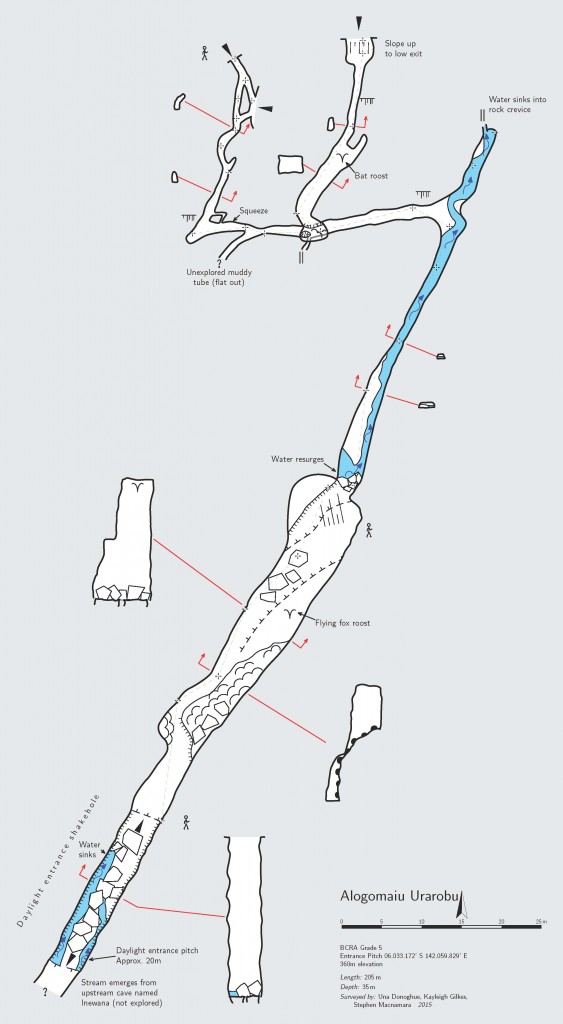Far from the floods back home, a team of fifteen cavers, mostly from Ireland, spent Christmas and New Year exploring caves in the Papua New Guinea rainforest.
The Kosua tribe own land near Mount Bosavi in the Southern Highlands province of Papua New Guinea. In 2011/12 a successful reconnaissance expedition had explored caves around the village of Fogoma’iu. This year, the larger team pushed higher up into the dense uninhabited forest on the Darai Plateau, surveying a total of 8.036km in 35 caves.

To reach Fogoma’iu, which has no road, had taken 4 planes and a long road journey before the final charter flights, one for the team and one for the food, caving kit, camping supplies and medical equipment. Within the tribal lands themselves, all travel was on foot and distances are measured not in kilometres or miles but in number of days travel. For Western cavers a day’s travel turned out to mean anything as little as 3 kilometres in an 8 hour hike through the rough pinnacle karst of the plateau.
The Kosua people had located the entrances, many of which, although large, could have been easily missed in the dense rainforest. To cover more ground the team split into smaller groups, each of which spent up to eight days away from the village. The majority of the caves surveyed were short and were left without going leads. The villagers had described large caves at Peneane and Keani. The only problem was that no one had been there in nearly 20 years.
Peneane turned out to be a traditional hunting camp rock shelter with three caves within 10 minutes walk of camp: Soya, Soiyegini and Wani. All three caves had reasonably large entrances, all three were full of flying foxes but unfortunately all three petered out after 150-200m with no potential leads.

At Keani, no one could find the intended cave, but the team was taken to another, also referred to as Keani cave. The large entrance led to an impressive 41m pitch which dropped into a light-swallowing chamber, however all hopes for the big one were dashed after a short crawl and a further pitch led to a too tight hole which would require digging.
Despite disappointment with the headline caves both teams did find caves with potential. Hayamaene was explored on route to Peneane and provided multiple stomping passageways which required three subsequent teams to push, past large quantities of guano deposited by generations of flying foxes. After many trips most of the leads had terminated either at sumps or possible dig sites and the cave had yielded 2.8km of passageway.
Kabaleki was explored on Christmas day returning from Keani. Expecting a short cave similar to others they had explored, the team only allowed a morning to look at it before continuing the descent back towards Fogoma’iu. A tight constriction at the top of the entrance pitch required some wriggling to pass. At the base of the pitch a chamber containing some fine gours had two possible continuations. One was left unexplored due to time constraints, whilst the other led down a climb passing two pots which were left un-dropped, to a small chamber where a climb entered the side of a rift with a tempting passage disappearing under the false floor.
In addition to the trips to Peneane and Keani, teams visited camps belonging to some members of the Kosua tribe. At all of these camps excellent hospitality was provided.
The team at Joe’s camp explored four caves and two short pots. One of these had an underground lake, the water of which previous generations apparently used to cure a variety of medical ailments by bathing in it. Nobody had been in the cave in recent generations and whilst the expedition team used SRT equipment to descend the walls of the 50m wide collapsed doline, tribal bathers would have historically had a hairy free climb to reach the healing waters of the underground lake.
The team left one substantial lead in the area. Urianati was surveyed to over 350m during the initial visit with another 200m or so of active going stream way looked at but not surveyed. A stomping side passage shortly inside the entrance was also left unexplored due to time restrictions.

Dan’s camp was the location of the cave that lured the original expedition to the Kosua’s land, Natapere cave, which was explored by Tim Fogg and Dan himself back in the days of the 2008 BBC visit to the Kosua while filming ‘The Lost Land of the Volcano’ series. The 2011 team had been unable to visit the impressive entrance with its abundance of swifts which served as a camp site for this year’s team over the few days of exploration. The excitement of reaching Natapere was quickly dampened, however, when a few hundred metres inside the cave, the limit of previous exploration was reached and no further progress could be made. Other caves of similar dimensions were also explored in the area but the most interesting was a river cave nearby which was reasonably complex and out of character for the area.

Willie’s camp had been visited by the 2011 expedition, but since then new caves had been located on his land. Of the six caves explored the most substantial was Alogomaiu, which was entered after descending into a large shake hole either using SRT or the local climbing down branches technique. Upstream in the shake hole was left unexplored whilst downstream passed through large bat filled chambers and small wet crawls to re-emerge on the other side of the pinnacle.
The Kosua have a rich cultural heritage which they willingly shared with us through stories and sing sing celebrations. They not only showed us caves for exploration but also rock shelters adorned with cave art carved by women who had lived there and the shelters where bones of their ancestors remain to this day.
The potential for caves on the Darai plateau and the surrounding area is immense; the team were told of a potentially massive pothole a further day’s walk from Peneane, the legendary Keani cave has yet to be found and who knows what else is waiting for the next trip.
Many thanks to our sponsors, SUI, Ghar Parau, MPOWERED/Luci, Decathlon Belfast, Microsoft and Pentax, who supplied us with funding and equipment which helped make the expedition a success.
Our thanks to Kayleigh Gilkes for this comprehensive report.
